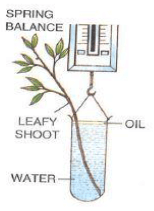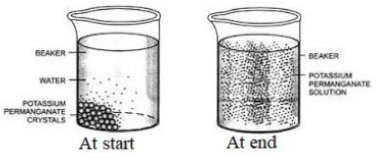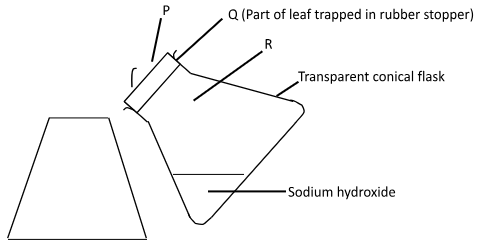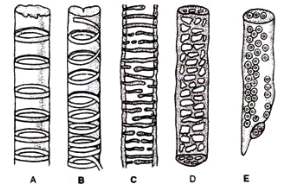INSTRUCTIONS TO CANDIDATES: -
- Answer all the questions
- Candidates should answer the questions in English.
- A student observed an insect wing under a hand lens and made a drawing whose length was 16cm with magnification of X4. Calculate the actual length of the wing in micrometers (3 mks)
-
- Name the cell organelle found in abundance in the white blood cells. (1mk)
- give a reason for your answer in (a) above (1mk)
- An individual is of blood group B positive.
- Name the antigens in the individual’s blood. (2mks)
- Give the reason why the individual cannot receive blood form a blood group A donor. (2mks)
-
- Name two digestive enzymes which are secreted in an inactive form. (2mks)
- How is surface area increased in the small intestines (2mks)
- State two functions of the body tube of the microscope. (2mks);
- Name the blood vessel that supply the blood to: -
- Heart muscles (1 mark)
- Kidney (1 mark)
- Distinguish between the lymphocytes and phagocytes. (2mks)
- The diagrams below shows two organelles Q and R.
- Identify the organelles Q and R (2 marks)
-
- Explain why the organelle R would be abundant in a sperm cell. (1 mark)
- State the function of the structure marked A in the organelle R (1 mark)
-
- Name the enzyme in erythrocytes that speeds up conversion of carbon (IV) oxide to carbonic acid. (1mk)
- Name the disease that causes thickening and hardening of arteries (1mk)
- Organisms are grouped into various kingdoms. Name three kingdoms where members (all or some) are unicellular. (3mks)
- The scientific names of three animals, leopard, wolf and lion are Panthera pardus, Canis lupas and Panthera leo respectively.
- Why are scientific names given in latin? (1mk)
- What does Canis refer to? (1mk)
- Giving a reason, state the organisms that are most closely related. (2mks)
- Define species (1mk)
-
- Knowledge in a certain branch of biology is applied when dealing with locusts that infest a maize crop. Name the branch of biology. (1mk)
- Explain the importance of the following in living organisms.
- Nutrition. (1mk)
- Excretion. (1mk)
- Enumerate ways in which aerobic respiration differs from photosynthesis. (3mks)
- Outline two ways in which Respiration is exploited in in industry and domestic field by man. (2mks)
- The following set up was placed in the sunshine for 1 hour to study a physiological process

- What was the role of oil in the set up? (1mk)
- Account for observation made after 1 hour (2mks)
- A Class set up the experiment below to investigate some factors necessary for photosynthesis. Study the set up and answer the question that follow.
Before the apparatus were set up in the light, the potted plant was kept in a total darkness for 48 hours.- What was the purpose of keeping in darkness? (1 mark)
- State the colours obtained at the end of the experiment after the leaf was tested for starch. (3 marks)
- P
- Q
- R
- Explain the effect of the factors listed below to the process of active transport.
- Optimum temperature (2 marks)
- High oxygen concentration (3mks)
- The following are patterns of lignification of a tissue found in flowering plants
- Identify the patterns labelled
- A (1mk
- C 1mk
- Give a non-transport function of the tissues shown above? (1mk
- Give TWO adaptations of the tissues above to their transport function (2mks
- Identify the patterns labelled
- The following equation is a summary of a process in an animal muscle cell.
Glucose → lactic acid + energy-
- Name the process (1mk)
- In which part of the cell does the above process (a) (i) take place? (1mk)
- State two conditions under which the process in (a)(i) take place (3mks)
- Outline two processes in plants which require energy to take place (2mks)
-
-
- State two adaptations of the frog's skin to gaseous exchange. (2 marks)
- Explain how the human nasal cavity is adapted to gaseous exchange. (3 marks)
- Explain why the amoeba does not require an elaborate gaseous exchange system. (2 marks)
- Name the respiratory disease caused by Bordetella pertussis (1 mark)
- An experiment was set up as shown below. Study the diagram and answer the questions that follow.

- Name the physiological process being investigated. (1 mark)
- Account for the observation at the end of the experiment (3 marks)
- Account for the observation made if hot water was used at the start of the experiment. (2 mark)
- Name the property of the cell membrane that enables it detect changes in the environment (1 mark)
- How is the process named in a above important in predation (1mk)
-
- Describe six factors affecting breathing rate in humans (12 marks)
- Briefly describe the photosynthetic theory of stomatal opening. (8mks)
MARKING SCHEME
- A student observed an insect wing under a hand lens and made a drawing whose length was 16cm with magnification of X4. Calculate the actual length of the wing in micrometers (3 mks)
Magnification = drawing length
actual length;
4 = 16
actual length,
actual length = 16/4 = 4cm; 4X 10 000;=40 000µm -
- Name the cell organelle found in abundance in the white blood cells. (1mk)
- Lysosomes/Golgi bodies;
- Give a reason for your answer in (a) above (1mk)
- White blood cells fight pathogens to protect the body, the lysosomes contain lytic enzymes which destroy the pathogens; golgi apparatus synthesize lysosomes which contain lytic enzymes that destroy pathogens;
- Name the cell organelle found in abundance in the white blood cells. (1mk)
- An individual is of blood group B positive.
- Name the antigens in the individual’s blood. (2mks)
- Antigen B
- Rhesus antigen/rhesus factor/antigen D;
- Give the reason why the individual cannot receive blood form a blood group A donor. (2mks)
- Antibody a in the recipient’s blood plasma corresponds with antigen A in the donor blood; causing agglutination/ antigen – antibody reaction;
- Name the antigens in the individual’s blood. (2mks)
-
- Name two digestive enzymes which are secreted in an inactive form. (2mks)
- Pepsin;
- Trypsin;
- How is surface area increased in the small intestines (2mks)
- numerous villi/microvilli;
- Long;
- Name two digestive enzymes which are secreted in an inactive form. (2mks)
- State two functions of the body tube of the microscope. (2mks)
- Holds the revolving nose piece/ objective lenses in place;
- Hold the eye piece lens in place;
- Name the blood vessel that supplies the blood to: -
- Heart muscles (1 mark)
- Coronary artery;
- Kidney (1 mark)
- Renal artery;
- Heart muscles (1 mark)
- Distinguish between the lymphocytes and phagocytes. (2mks)
Lymphocytes Phagocytes lack granules in cytoplasm has granules in cytoplasm nucleus is spherical/ bean shaped Nucleus is lobed. - The diagrams below shows two organelles Q and R
- Identify the organelles Q and R (2 marks)
- Q - Rough endoplasmic reticulum;
- R - Mitochondrion;
-
- Explain why the organelle R would be abundant in a sperm cell. (1 mark)
- It serves as a respiratory site which yields energy / ATP; necessary for swimming / movement of the sperm cell towards the ovum;
- State the function of the structure marked A in the organelle R (1 mark)
- Increases the surface area for attachment of respiratory enzymes/ respiratory reactions which yield energy for the cell;
- Explain why the organelle R would be abundant in a sperm cell. (1 mark)
- Identify the organelles Q and R (2 marks)
-
- Name the enzyme in erythrocytes that speeds up conversion of carbon (IV) oxide to carbonic acid. (1mk)
- Carbonic anhydrase;
- Name the disease that causes thickening and hardening of arteries (1mk)
- Arteriosclerosis;
- Name the enzyme in erythrocytes that speeds up conversion of carbon (IV) oxide to carbonic acid. (1mk)
- Organisms are grouped into various kingdoms. Name three kingdoms where members (all or some) are unicellular. (3mks)
- Monera;
- Protoctista;
- Fungi;
- The scientific names of three animals, leopard, wolf and lion are Panthera pardus, Canis lupus and Panthera leo respectively.
- Why are scientific names given in latin? (1mk)
- Latin language does not change with time
- Latin language was widely used during Linnaeus time
- What does canis refer to? (1mk)
- Generic name for wolf
- Giving a reason, state the organisms that are most closely related. (2mks)
- Leopard and lion; they share same genus name;
- Define species (1mk)
- Group of organism that freely and naturally interbreed to produce a fertile offspring;
- Why are scientific names given in latin? (1mk)
-
- Name the branch of biology whose knowledge is applied when dealing with locusts that infest a maize crop. (1mk)
- Entomology
- Explain the importance of the following in living organisms.
- Nutrition. (1mk)
- Provide materials required for growth;
- Provide materials required to produce energy;
- Excretion. (1mk)
- Removal of waste products of metabolisms that may interfere with normal functioning of body/cells if allowed to accumulate;
- Nutrition. (1mk)
- Name the branch of biology whose knowledge is applied when dealing with locusts that infest a maize crop. (1mk)
- Enumerate ways in which aerobic respiration differs from photosynthesis. (3mks)
- It releases energy in form of adenosine triphosphate (ATP);
- It releases CO2;
- A food substrate is oxidized;
- It occurs in the mitochondria /in all cells;
- It occurs in presence or absence of light;
- Outline two ways in which respiration is exploited in industry and domestic field by man. (2mks)
- Baking of bread/cakes;
- Brewing of alcohol/beer/wine;
- Production of biogas;
- Fermentation of dairy products/sour milk /yoghurt production;
- Production of vinegar;
- Production of acetic acid; etc
- The following set up was placed in the sunshine for one hour to study a physiological process
- What was the role of oil in the set up? (1mk)
- Prevent evaporation of water;
- Account for observation made after one hour (2mks)
- Will weigh less/amount of water in tube will reduce; since water molecules will be absorbed by the plant then lost via transpiration (through the stomata/cuticle/lenticels);
- What was the role of oil in the set up? (1mk)
- A Class set up the experiment below to investigate some factors necessary for photosynthesis. Study the set up and answer the question that follow.
Before the apparatus were set up in the light, the potted plant was kept in a total darkness for 48 hours.- What was the purpose of keeping in darkness? (1 mark)
- To destarch the leaf
- State the colours obtained at the end of the experiment after the leaf was tested for starch. (3 marks)
- P - Blue black
- Q - Brown
- R - Brown
- What was the purpose of keeping in darkness? (1 mark)
- Explain the effect of the factors listed below to the process of active transport.
- Optimum temperature (2 marks)
- Respiratory enzymes would be more active leading to more energy release; hence a faster rate of active transport;
- High oxygen concentration (3mks)
- Aerobic respiration would be faster; more energy release; hence faster rate of active transport;
- Optimum temperature (2 marks)
- The following are patterns of lignification of a tissue found in flowering plants
- Identify the patterns labeled
- A - Annular; (1mk
- C - Reticulate; (1mk
- Give a non-transport function of the tissues shown above? (1mk
- Strengthen/Support;
- Give TWO adaptations of the tissues above to their transport function (2mks
- Made of dead cells in order not to utilize water molecules during transport;
- Narrow lumen to increase capillarity of water;
- Lignified wall to keep the lumen open for water molecules movement;
Mark 1st 2
- Identify the patterns labeled
- The following equation is a summary of a process in an animal muscle cell.
Glucose → energy + lactic acid-
- Name the process (1mk)
- Anaerobic respiration;
- In which part of the cell does the above process (a) (i) take place? (1mk)
- Cytoplasm;
- State two conditions under which the process in (a)(i) take place (2mks)
- Absence/inadequate oxygen supply;
- Optimum temperature;
- Presence of specific enzyme;
- Presence of suitable/optimum pH;
- Name the process (1mk)
- Outline two processes in plants which require energy to take place. (2mks)
- Cell division process;
- Photosynthesis acc. Photolysis;
- Mineral salts absorption by root hairs;
- Movement of water across endodermis into the xylem;
- Translocation of sugars in phloem;
-
-
- State two adaptations of the frog's skin to gaseous exchange. (2 marks)
- Moist to dissolve respiratory gas for faster gaseous exchange;
- Thin /Lined with a one-cell-thick epithelium for faster diffusion of respiratory gases;
- Highly vascularized for faster/efficient transportation of respiratory gases; Any two
- Explain how the human nasal cavity is adapted to gaseous exchange. (3 marks)
- Lined with hair; to trap dust particles/foreign materials/purify (the incoming) air,
- Has mucus; to moisten/warm the incoming air
- Explain why the amoeba does not require an elaborate gaseous exchange system. (2 marks)
- Has a large surface area to volume ratio; diffusion (across its cell membrane) is adequate;
- Name the respiratory disease caused by Bordetella pertussis (1 mark)
- Whooping cough;
- State two adaptations of the frog's skin to gaseous exchange. (2 marks)
- An experiment was set up as shown below. Study the diagram and answer the questions that follow.
- Name the physiological process being investigated. (1 mark)
- Diffusion
- Account for the observation at the end of the experiment (3 marks)
- The purple colour of potassium permanganate solution had spread evenly throughout the water in the beaker; due to the random motion/movement of Potassium manganate (VII) molecules; which causes them to move from a region of high concentration to a region of low concentration.;
- Account for the observation made if hot water was used at the start of the experiment. (2 mark)
- Hot water causes an increase in kinetic energy of molecules; this causes faster spread of purple colour to the areas of low concentration
- Name the property of the cell membrane that enables it detect changes in the environment ( 1 mk)
- It has electric charges
- How is the process named in (a) above important in predation (1mk)
- It enables the prey detect presence of predators through smell/ Enables predators to detect presence of prey through smell;
- Name the physiological process being investigated. (1 mark)
-
- Describe six factors affecting breathing rate in humans (12 mks)
- Age; young people breath faster than the old because they have a higher demand for oxygen;
- Temperature; in higher temperature, the breathing rate increases but in too high temperature the rate increases;
- Health; increase of fever increases metabolism hence high breathing rate;
- Exercise; during vigorous exercise the rate of breathing increases to supply more oxygen to meet the demand and also remove the extra CO2 produced during respiration;
- Altitude; at high altitude, Oxygen concentration is low thus faster rate of breathing to supply tissues with sufficient Oxygen;
- Emotions; affect production of hormone adrenaline which increases metabolism hence more rate of breathing e.g in anxiety, fright;
- Briefly describe the photosynthetic theory of stomatal opening. (8mks)
- Guard cells have chloroplasts; hence the presence of light/ during the day photosynthesis occurs in the guard cells; producing sugar in the guard cells that increases osmotic pressure; water from epidermal cells enters into guard cells; by osmosis causing turgidity of cells; the inner walls of the guard cells are thicker than outer walls; hence outer walls stretch more (during turgidity); causing guard cells to bulge outwards; (stomata open).
TOTAL MARKS 10 MAX 8
- Guard cells have chloroplasts; hence the presence of light/ during the day photosynthesis occurs in the guard cells; producing sugar in the guard cells that increases osmotic pressure; water from epidermal cells enters into guard cells; by osmosis causing turgidity of cells; the inner walls of the guard cells are thicker than outer walls; hence outer walls stretch more (during turgidity); causing guard cells to bulge outwards; (stomata open).
- Describe six factors affecting breathing rate in humans (12 mks)
Join our whatsapp group for latest updates
Tap Here to Download for 50/-
Get on WhatsApp for 50/-
Download Biology Questions and Answers - Form 2 Term 3 Opener Exams 2023.
Tap Here to Download for 50/-
Get on WhatsApp for 50/-
Why download?
- ✔ To read offline at any time.
- ✔ To Print at your convenience
- ✔ Share Easily with Friends / Students




